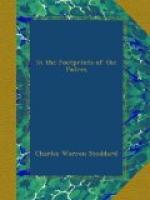I can remember how scanty the foliage was—it resembled a little the toy-villages that are made in the Tyrol, having each of them a handful of impossible trees that breathe not balsam, but paint. I remember the high wind that blew in bravely from the sea; the pavilion that was a wonder-world of never-failing attractiveness; and how on a certain occasion I watched with breathless anxiety and dumb amazement a man, who seemed to have discarded every garment common to the race, wheel a wheelbarrow with a grooved wheel up a tight rope stretched from the ground to the outer peak of the pavilion; and all the time there was a man in the wheelbarrow who seemed paralyzed with fright,—as no doubt he was. The man who wheeled the barrow was the world-famous Blondin.
[Illustration: Russ Gardens, 1856]
Another sylvan retreat was known as “The Willows.” There were some willows there, but I fear they were numbered; and there was an al fresco theatre such as one sees in the Champs-Elysees; indeed, the place had quite a Frenchy atmosphere, and was not at all German, as was Russ’ Garden. French singers sang French songs upon the stage—it was not much larger than a sounding-board.
An air of gaiety prevailed; for I imagine the majority of the habitues were from the French Quarter of the city. Of course there were birds and beasts, and cages populous with monkeys; and there was an emeu—the weird bird that can not fly, the Australian cassowary. This bird inspired Bret Harte to song, and in his early days he wrote “The Ballad of the Emeu”;
O say, have you seen at the
willows so green,
So charming and
rurally true,
A singular bird, with the
manner absurd,
Which they call
the Australian emeu?
Have
you
Ever seen this
Australian emeu?
I fear the poet was moved to sarcasm when he sang of “the willows so green, so charming and rurally true.” Surely they were greener than any other trees we had in town; for we had almost none, save a few dark evergreens. Well, the place was charming in its way, and as rurally true as anything could be expected to be on that peninsula in its native wilderness. The Willows and Russ’ Garden had their day, and it was a jolly day. They were good for the people—those rural resorts; they were rest for the weary, refreshment for the hungry and thirsty—and they have gone; even their very sites are now obliterated, and the new generation has perhaps never even heard of them.
How we wondered at and gloried in the Oriental Hotel! It was the queen of Western hostelries, and stood at the corner of Battery and Bush Streets. And the Tehama House, so famous in its day! It was Lieutenant G.H. Derby, better known in letters as John Phoenix, and Squibob—names delightfully associated with the early history of California,—it was this Lieutenant Derby, one of the first and best of Western humorists, who added interest to the hotel by writing “A Legend of the Tehama House.” It begins, chapter first:




